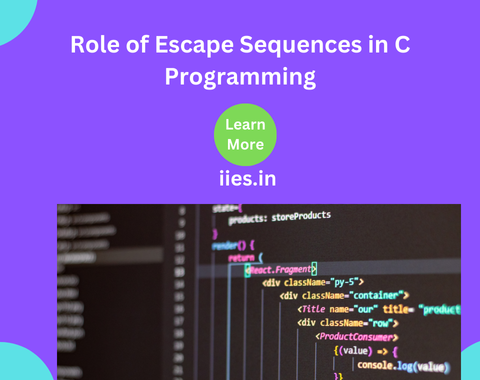
In C programming, escape sequences are essential tools for handling non-printable characters that help control the output display. An escape sequence begins with a backslash (\), followed by a letter or digit, enabling you to perform specific formatting actions, such as moving text to a new line (\n) or creating tabs (\t). These sequences communicate with display devices or printers to produce actions beyond standard text display, giving programmers a way to format output effectively.
For instance, if we print without a newline character, output appears on a single line. By adding \n, we can create cleaner, readable output that starts a new line as needed. Similarly, the tab character \t is used to add horizontal spaces in output, aligning text into organized columns. Other escape sequences, such as \' for single quotes, \" for double quotes, and \a for an alert sound, expand control over text formatting in different ways.
Escape sequence: Escape sequences are sequences \ followed by letter or digit.
Escape sequence are non-printable and are used to communicate with display device or printer by sending non-graphical control characters to specify actions like new line and tab space.
\n-newline character-goes to the next line.
Without newline
————————-
#include
int main()
{
printf(“hi”);
print(“welcome to iies”);
return 0;
}
With newline
———————
#include
int main()
{
Printf(“hi\n”);
Printf(“welcome to iies”);
}
What happens without newline character:
\t-leaves the tab (8 )character..
————————————
#include
int main()
{
printf(“welcome \t to iies”);
}
The output could be
#include
int main()
{
printf(“welcome\t to iies\n”);
printf(“welcome \t to iies\n”);
printf(“welcome \t\t to iies\n”);
}
ANSWER
———–
welcome to iies
welcome to iies
welcome to iies
Whenever u r using th \t tab character;
\’ – adding single quotes
——————————–
#include
int main()
{
char c=’\”;
printf(“welcome\t \’to iies\n”);
printf(“welcome \t to iies\n”);
printf(“welcome \t\t to iies\n”);
}
\”-adding double quotes
———————————
#include
int main()
{
char c[10] = “\””;
printf(“welcome\t \”to iies\n”);
printf(“welcome \t to iies\n”);
printf(“welcome \t\t to iies\n”);
printf(“%s”,c);
}
Output
———-
welcome “to iies
welcome to iies
welcome to iies
“
\b-backslash moves one position backward from the end
\b\b-moves two position from the end.
#include
int main()
{
char c[10] = “\””;
printf(“welcome\b \”to iies\n”);
printf(“welcome\b\b\bto iies\n”);
printf(“welcome \b\b\b\b\bto iies\n”);
printf(“%s”,c);
}
Output
welcom “to iies
welcto iies
welto iies
“
\r-carriage return
#include
int main()
{
char c[10] = “\””;
printf(“welcome\r \”to iies\n”);
printf(“welcome\r\r\rto iies\n”);
printf(“welcome \r\r\r\r\rto iies\n”);
printf(“%s”,c);
}
Output
to iies
to iies
to iies
“
\a-gives the beep sound
#include
int main()
{
printf(“welcome\ato iies\n”);
return 0;
}
\f:
It is primarily used to move the cursor to the beginning of the next “page” or a new line, depending on the environment.
#include
int main() {
printf(“Hello, World!\fGoodbye, World!”);
return 0;
}
Indian Institute of Embedded Systems – IIES